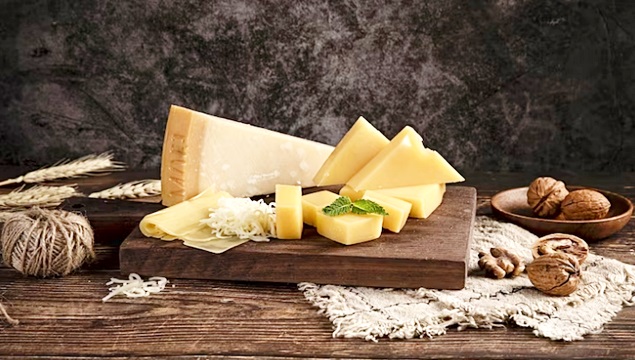
Havarti or cream havarti is a Danish semi-soft cheese made from cow's milk that can be sliced, grilled, or melted. Being very tasty, it has sparked international controversies.
A Danish Tilsit
Havarti was initially named "Danish Tilsiter" after the German Tilsiter cheese. Danish production began in 1921. In 1952, the cheese was named Havarti after Havartigarden Holte, where Danish cheese pioneer Hanne Nielsen worked in the 19th century. Among other cheeses, Nielsen created a Tilsit cheese with caraway for King Christian IX of Denmark.
Some sources, such as The Oxford Companion to Cheese, claim that Nielsen invented Havarti cheese, while Dansk Biografisk Leksikon states that the current Havarti is not based on this original source.
Original Havarti cheese is different from flodehavarti (cream Havarti), which is made from pasteurized milk. This increases yield but alters the taste and texture. Cream Havarti is usually minimally aged because the remaining whey proteins cause issues (unpleasant taste, odd appearance) during extended maturation.
Characteristics
Havarti is produced like most cheeses by introducing rennet into the milk to cause coagulation. The curd is pressed into cheese molds, drained, and then aged.
Havarti has traditionally been a rind cheese. It is a washed-rind cheese, which contributes to its subtle aroma, and is ripened internally without a rind, with a smooth and slightly glossy surface, ranging in color from cream to yellow, depending on the type. It has very small and irregular openings distributed throughout.
Havarti has a buttery flavor and can be somewhat tangy in stronger varieties, similar to Swiss-type cheeses. The taste is creamy, somewhat sweet, and slightly acidic. It is typically aged for about three months, although as the cheese ages, it becomes saltier and develops a nutty flavor. When left at room temperature, the cheese tends to soften quickly.
Production and Disputes
Denmark covers half of the world's Havarti production. Other significant producers in the EU are Germany and Spain. Internationally, the main producers are the United States and Canada, with other producing countries including Finland, Poland, France, Australia, and New Zealand.
Havarti is one of the twelve cheeses whose characteristics and manufacturing standards are registered in the Codex Alimentarius, starting from 2019.
In the same year, the EU granted Denmark exclusive rights to a protected geographical indication (PGI). It can now only be produced from Danish milk in authorized dairy factories to be sold in the EU and countries that have signed a trade agreement recognizing the PGI standards.
Immediately, there was strong opposition and pressure from the US against the recognition, which forced the EU to postpone the PGI status for a while, fearing that such certification could be seen as too provocative in the face of a political reaction from the United States.
The Consortium for Common Food Names (CCFN), an industry alliance based in Virginia, United States, representing the interests of the US Dairy Export Council and fighting against protected geographical indications, expressed its outrage at the EU's decision, arguing that the PGI status is not a "legitimate protection of intellectual property but hidden protectionism for the economic gain of Europeans."
Alongside the United States, Australia, New Zealand, Uruguay, and Argentina argue that havarti is a generic cheese and that the EU is attempting to "blatantly monopolize global trade."





